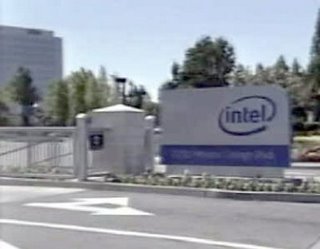INTEL CUTS 10,500 JOBS Worldwide in Sales, Marketing, Management; Not ENGINEERS; 10-15% in CHINA; SAVING $6 Billon to 2008; SHARES RATINGS: Buy & Sell
 Intel Malaysia: No news is good news; no announcement
Intel Malaysia: No news is good news; no announcement
Intel Spokesman Mark Petinger; “The cuts will make Intel a more nimble and a more efficient company. This isn’t an activity to reduce the number of positions in Intel; we are also looking at how the Intel structure operates”
Intel spared the engineers but there will be a great deal of redeployment and mergers and rationalizations in many unproductive research departments
Though the shares drop slightly there are mixed reports of the shares ratings; Banc of America maintained a price target of $25 and a "buy" whilst Standard & Poor a “sell”.
Intel Corp.: underweight (Prudential Financial)
Intel Corp.: buy (Citigroup)
Worldwide job-cuts at Intel Corporation are mainly concentrated in the Sales & Marketing Group (SMG).
The future of Intel was announced this morning at an internal Webex meeting presided over by Paul Otellini, Intel's chief executive officer.
It is estimated that more than 100 employees will lose their jobs in
A senior official at Intel
In the meantime, the company will be streamlined to enhance the efficiency of decision-making and implementation.
The Channel Platform Group, which was founded just last year, will be dropped from Intel's five groups (Mobility Group, Digital Enterprise Group, Digital Home Group, Digital Health Group and Channel Platform Group). The worldwide organizations of this group will be merged into the SMG.
Employees in the Shanghai region seem to have been prepared for this move. An anonymous staff member at Zizhu Science-based Industrial Park said that although his department had not announced a compensation scheme, some other departments had told their staff what would be happening.
Source: National Business Daily

Market Scan
Update -- Job Cuts Seen Boosting Intel Profits
R.M. Schneiderman, 09.07.06,
Updated stock movement and added analyst comments.
Intel's plan to cut roughly 10,500 jobs will be an earnings boon for the semiconductor giant, according to a Wednesday report from Banc of America Securities.
"We believe that Intel's announced restructuring actions…bode well for Intel's earnings power once fully implemented," wrote Sumit Dhanda, an analyst for the research firm and the author of the report.
"We view the stock as compellingly valued at current levels."
The headcount reduction, which will end by the second quarter of 2007, will boost earnings per share 24 cents in 2007, 12 cents in 2008 and two cents in 2009, according to Dhanda.
The plan, which was announced on Tuesday, will generate savings in costs and operating expenses of roughly $2 billion in fiscal 2007 and $3 billion in fiscal 2008.
Moving forward, the analyst said Intel may spin off its NOR Flash business.
That might reduce the company's revenues, said Dhanda, but it would give its earnings-per-share a boost.
Banc of
Not everyone was so positive, however.
David Kaplan, an analyst for Standard & Poor's Equity Research reiterated a "sell" recommendation on the company following the news.
"While we anticipated this cost reduction effort, we continue to expect further market share loss in the processor market and inventory writer offs," he said.
Indeed, over the past year, the company's margins have come under increased pressure from rival Advanced Micro Devices (nyse: AMD - news - people ). For the quarter that ended in December of 2005, Intel posted revenues of $10.2 billion and an operating income of $3.1 billion. By the July 2006 quarter, however, revenue had dropped to $8 billion and operating income fell to below $1.1 million.
Shares of Intel were down slightly in Thursday pre-market trading.
Massive Intel cuts likely to hit Chinese workers
By Liu Baijia (China Daily)
Updated: 2006-09-07
Xiao Wang had been lucky: she got an offer from Intel
In July, she also narrowly survived a layoff storm, in which the senior manager who recruited her lost his job.
But now, she is deeply anxious, as the
Intel said yesterday that it would shed 10,500 jobs from its workforce of 100,250 at the end of last quarter, including 7,500 this year and another 3,000 next year.
"These actions, while difficult, are essential to Intel becoming a more agile and efficient company, not just for this year or the next, but for years to come," Paul Otellini, Intel President and Chief Executive Officer, said in a statement.
The company said it was in a quiet period and suggested it would not reveal more details until it releases financial results on October 17.
The layoff will concentrate on management, marketing and information technology support functions, but will extend into manufacturing and product design units.
Nancy Zhang, a spokeswoman for Intel
However, analysts believe
The channel platforms group, one of Intel's six business groups and the only business with its headquarters in
The group was set up to design products to meet demands in different markets.
While that group and other units of Intel
Sources with Intel
A rapid expansion of business lines and a failure to pay enough attention to market changes are the major reasons behind Intel's historic layoffs.
Over the past three years, the company added more than 20,000 employees and established new business groups such as one for mobile phone chips and one for digital health.
Finding the funding was not a problem for the Intel of three years ago, which enjoyed an overwhelming dominance in the market and had a good cash flow. But competition, mainly from AMD, has eaten away at Intel's shares and profits, highlighting the importance of maintaining a lean and efficient organization.
In May and July, Intel launched two rounds of price wars with AMD and by the end of the second fiscal quarter on July 1, the company's revenue stood at US$8 billion, down 13 per cent, while operating income fell by as much as 60 per cent year-on-year to US$1 billion.
Statistics from the US Semiconductor Industry Association show the shipment of computers rose by 10 per cent in the second quarter over the same period of last year, but the average price of a laptop computer fell by 18 per cent due to competition.
Simon Ye, principal analyst of computer systems with the research house Gartner, said Intel's difficulties are related to the market trend.
Intel, famous for controlling computer makers with its technologies and marketing strategies, was focused on expanding into new territories such as mobile phones and maintaining the
However, it failed to pay attention to computer vendors' demand for another computer chips supplier and AMD's focus on new technologies in 64 bit computing and dual-core processors, which are especially useful in handling complicated enterprise computing, won the confidence of computer makers.
In contrast to Intel's financial performance, AMD's net sales rose by more than 50 per cent in the second quarter ending on July 2 at US$1.22 billion, while operating income grew by almost 23 per cent year-on-year.

Published:
Intel unveils massive job cuts to save $6b by 2009
Reuters
The cuts, along with other cost-cutting measures stemming from a three-month top-to-bottom review of operations, would help the technology giant save $1 billion this year, $2 billion next year, and $3 billion in 2008, the chip maker said.
Intel shares fell 25 cents, or 1.3 per cent, to $19.74 in extended trading following the announcement of the cuts, which were at the low end of the 9,000 to 15,000 jobs analysts expected would be shed.
Analysts have said Intel, the world's biggest microchip maker, needs to take drastic action to reverse sliding profits and halt steady market share gains by its far smaller rival, AMD that gathered steam in 2005.
"I am impressed by the magnitude of the cost savings in getting to $3 billion," said Doug Freedman, an analyst with American Technology Research. "The $3 billion is a welcome surprise and I'm sort of glad they can do it without cutting more people."
The cuts, Intel's largest in 21 years, include 1,000 managers Intel laid off in July and 2,000 workers in two business units that it sold over the past few months. Another 2,000 jobs will disappear through attrition.
"These actions, while difficult, are essential to Intel becoming a more agile and efficient company, not just for this year or the next, but for years to come," Chief Executive Paul Otellini said in a statement.
Intel said it would take a charge of $200 million in severance costs.
Highlighting Intel's recent difficulties, market research firm iSuppli said on Tuesday that its share of total microchip industry revenue hit a four-year low in the second quarter.
"Intel's recent actions show it understands the need to improve its efficiency and sharpen its focus on its core business of microprocessors and integrated circuits for computing systems," iSuppli Vice President Dale Ford said.
Keen to regain market share and the technological lead over AMD, Intel has slashed prices and revamped its entire line of microprocessors for desktop, laptop and server computers in recent months.
The latest round of job cuts was not as extreme as some scenarios discussed by analysts, such as jettisoning the company's flash memory chip business, but analysts said it showed management was moving in the right direction.
Most of the reductions will hit management, marketing and information technology workers, but they would not be concentrated in any specific geographic area, Intel said.
Freedman said the fact Intel was not shedding engineers was positive, though he expected it to divert some of them away from research efforts with few commercial prospects.
A Malaysian newspaper said that Intel would offer voluntary layoffs to up to 2,000 workers in that country, where the company has employed 10,000 people for assembly, packaging and testing.
Intel also has major operations in Israel, Ireland, and the US states of Oregon and Arizona.
By Ivan Gale, Staff Reporter
The 10 per cent cut in company staffing likely reflects Intel's desire to fall back and focus on its core businesses of microprocessors and PC-related equipment, said Mark Walker, director of business development for IDC Middle East and
"The focus here will not be on job cuts. This is where their bread and butter business is," he said. "My sense is that this will be more a US-based cutback." While the US is Intel's biggest market, "it is not necessarily its biggest future," he said.
Intel initiatives that could bear fruit in the region include the development of WiMAX long-range wireless broadband, a technology that could replace wired internet access. Intel has also established research and development centers in Cairo and Istanbul.
An Intel spokeswoman declined to comment.
GoTo TOP (Main Page)



2 Comments:
COOL...GOOD NEWS...coz Intel ppl so damn show off!!
You're cutting away Information Technology jobs?
it support
Post a Comment
<< Home